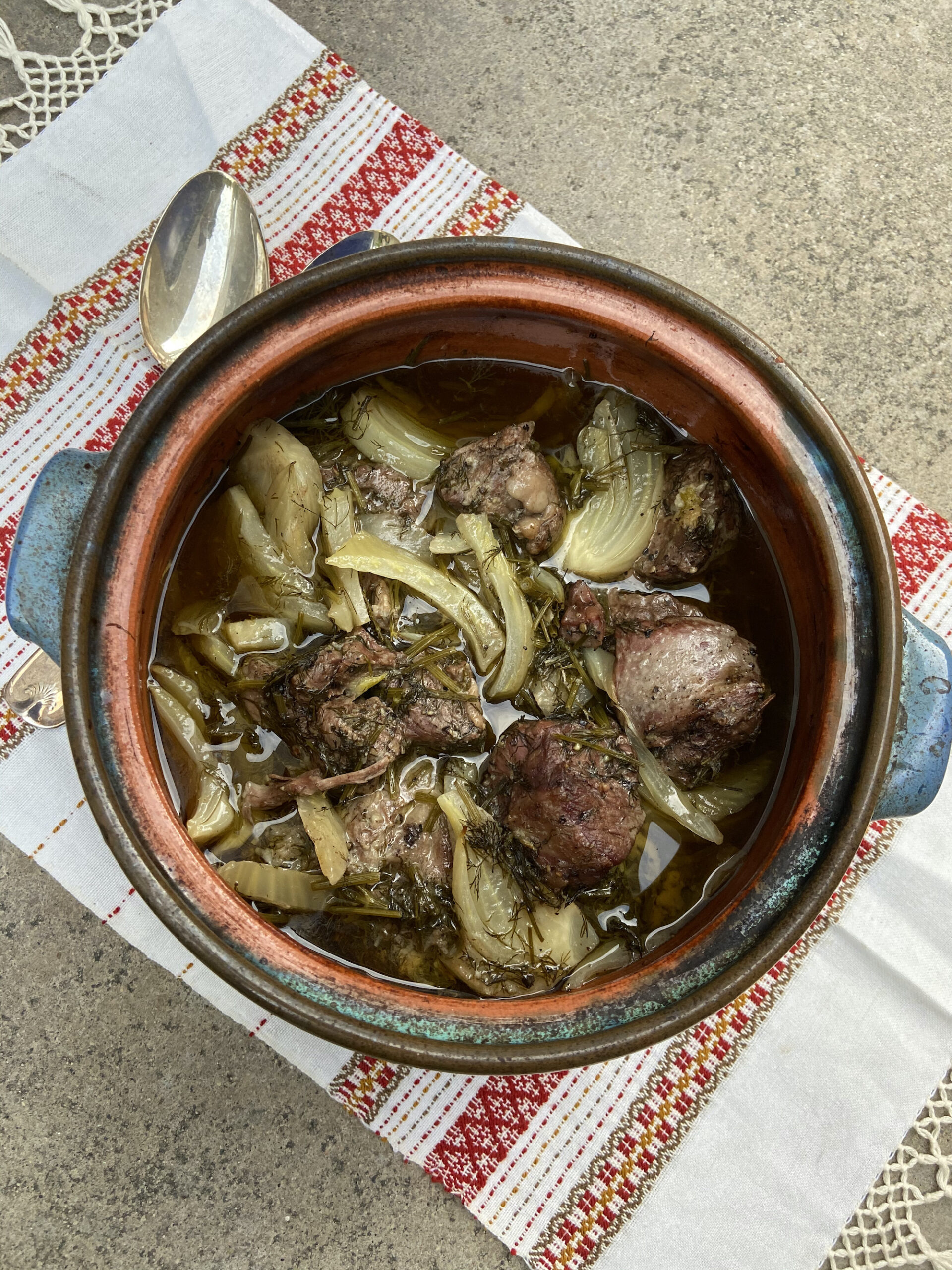Lamb Mastelo is a simple dish from the island of Sifnos, perfect for a spring celebration.
Lamb Mastelo is a traditional dish of slowly braised lamb with aromatics from the island of Sifnos in the southern Aegean. The dish takes its name from the wide-mouth clay pot in which you bake it. Sifnos has a long history of pottery. And these clay pots are typical of the style. You will find them throughout the island in a variety of shapes and sizes. The residents of Sifnos bake a variety of dishes in these pots, including a simple chickpea soup/stew and this dish.
Lamb Mastelo in years past
Traditionally in Greece, each village would have one main wood-fired oven. After the baker baked bread for the day, the residents of the village would bring their pots of food to cook using the residual heat of the oven. That’s why this dish cooks low and slow for the most part, mimicking that low temperature. These days, most of us have ovens in our home, so we don’t need to worry about that. But I love the idea of community cooking.
When to eat Lamb Mastelo
In Greece lamb people eat lamb in the spring, mainly for Easter, which is when families traditionally served this dish. Now, with increased availability of ingredients you will likely have the opportunity to eat Mastelo even if you visit Sifnos throughout the year. This is a dish that I love making for my pop-up dinners. The recipe is also easy to double, or even triple depending on who you have coming over for dinner.
Where did this recipe come from?
This is my riff on the Mastelo that I learned to make with George Narlis of Narlis Farm in Sifnos. If you’re ever visiting the island, I highly recommend spending an afternoon with him learning about the culinary traditions of Sifnos, his famous dry-farmed and flavor packed produce, and making the island’s iconic dishes.
Recipe notes
You don’t need a traditional clay pot to make this dish. Any oven safe pot or Dutch oven will work. One thing to note is you want a very tight seal on the lid of the pot. In this recipe, I’m using aluminum foil to create the seal (watch the step-by-step sequence to see how I do that). Traditionally, the residents on the island make a dough seal with 200 grams of flour and 120 grams of water. Then you mold the dough around the lid of the pan to create a tight seal. You can do it which ever way you want. If you’re using a heavy lidded Dutch oven like a Le Creuset or equivalent, you may not even need to make the seal because it is unlikely any of the steam will escape.
Ingredients
- 2 pounds boneless leg of lamb, cut into 2-inch cubes
- 2 cups dry white wine, or enough to just cover the meat
- 2 bunches dill, rough chop
- 1 fennel bulb, cut vertically with fronds reserved
- 4 garlic cloves, minced
- 5-6 rosemary sprigs
- 1/4 cup extra virgin olive oil
- 2 teaspoons kosher salt
- 2 teaspoons black pepper
Instructions
- Preheat your oven to 500ºF. Assemble all ingredients.
- In a large bowl, add all ingredients except rosemary and wine. Toss together to season everything well.
- Place rosemary sprigs in a single layer on the bottom of your pot.
- Transfer the lamb/fennel mixture from the mixing bowl to the pot on top of the rosemary.
- Pour in the wine.
- Cover the top of the pot with aluminum foil, making sure to seal it tightly. Put the lid on the pot and seal that with aluminum foil. Traditionally, you would make a dough seal with 200 grams of flour and 120 grams of water, which you can also do if you want.
- Bake at 500ºF for 30 minutes. The lower heat to 300ºF and continue baking for another 3-3 1/2 hours until the lamb is tender.
- Remove lamb from the oven. Remove foil seal. Adjust seasonings to taste. Serve over roasted potatoes, or rice pilaf.




This braised lamb dish is a traditional choice from Sifnos. Although lamb is popular all over Greece, there are some regional differences that are worth exploring.